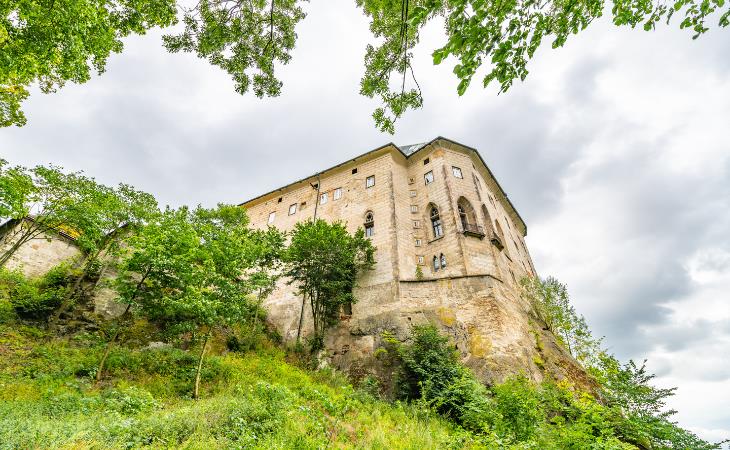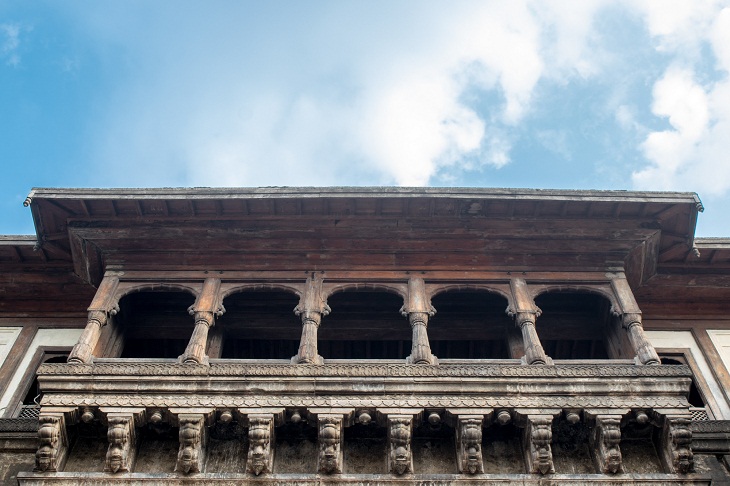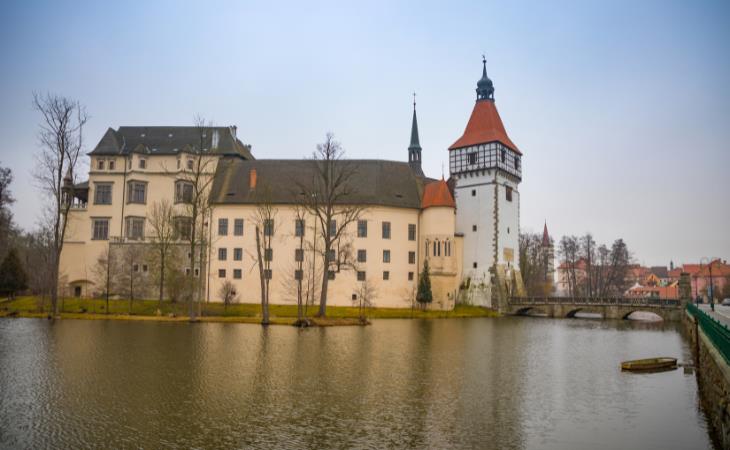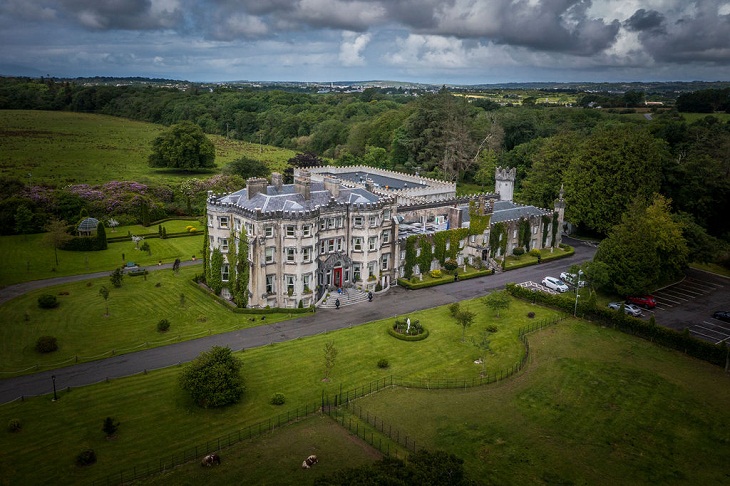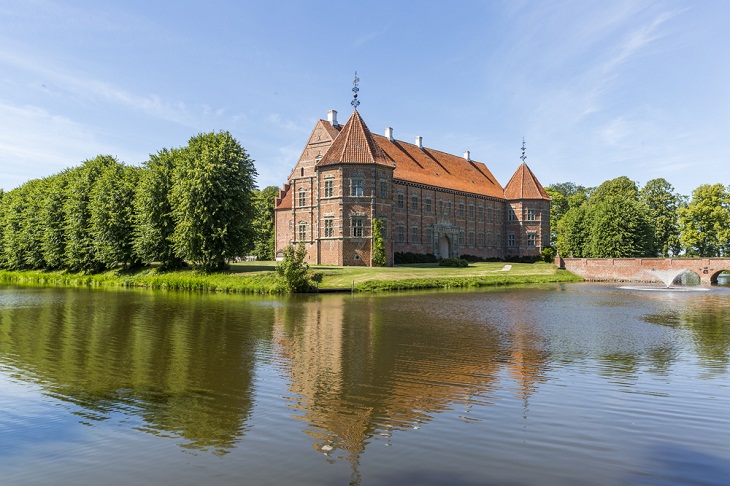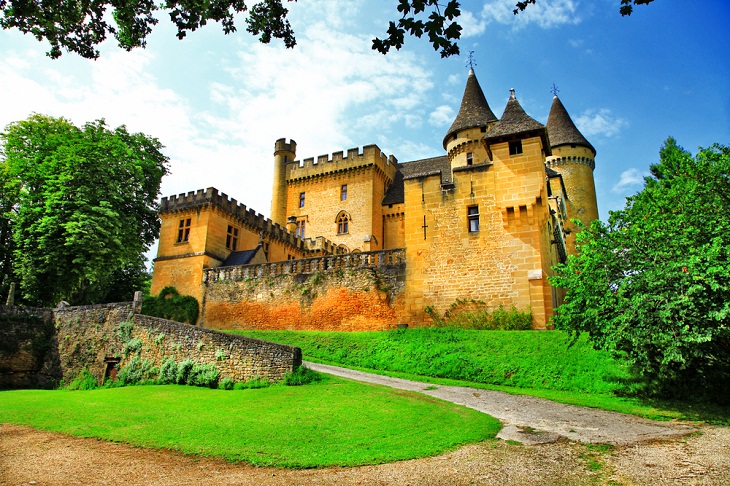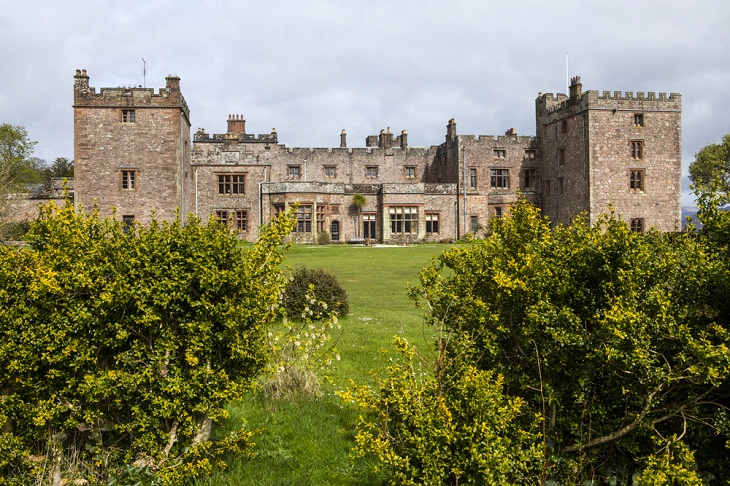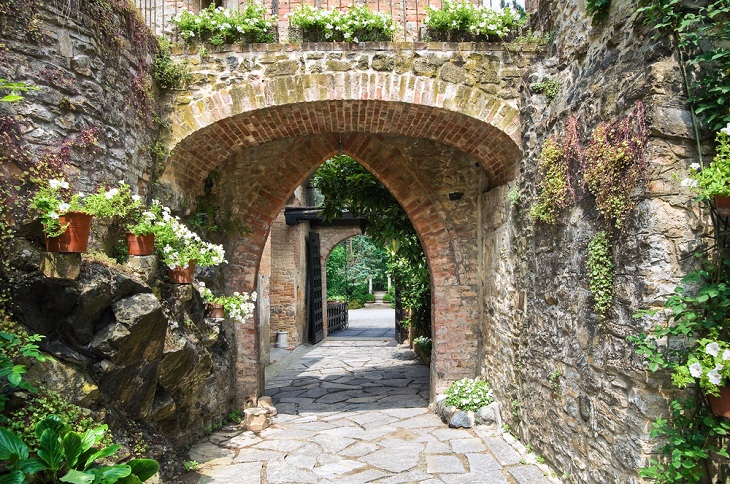Once known as 'the Impregnable Castle of Bohemia' because of its thick walls, Waldau Castle has now turned into a picturesque ruin. Built by the Teutonic Order in the 13th century, the castle is located in the small Russian village of Nizovye. This village was known as Waldau when the lands were part of Germany's East Prussia before the end of WWII.
Today, Waldau Castle is run by Nadezhda Sorokin, whose family started the restoration of the rundown place several years ago. However, the Sorokin family never visits the main building of the castle after dark. They say some inexplicable things happen there: creepy sounds, things suddenly falling, equipment breaking, etc. One night, the family had to stay there after dark because of a photo session. Strangely, all of the photos were ruined, and the cameras broke. The family is convinced that the place is haunted by the ghosts of the former owners, who wander the castle at night and dislike being disturbed.
2. Houska Castle, Czech Republic
Houska Castle, located north of Prague, is a Gothic structure built upon a cliff during the 13th century. The mysterious castle has no fortifications, no kitchen, and no water source. When it was built, it had no occupants. The most curious part of this structure is that it has a large hole in the ground known as the Gateway to Hell! According to folklore, demonic half-human and half-animal creatures crawled out of the pit at night. They used to attack locals and drag them down the hole. To keep those demonic creatures from entering our world, the castle was built to seal the gateway.
Here’s something more bizarre. As construction of the castle began, it's said that the village's prisoners were offered pardons if they agreed to be lowered into the bottomless pit by rope and report back what they saw. When the first man was tied up and lowered into the hole, he started screaming after a few seconds. They say that when he was pulled back up, he looked as if he had aged 30 years!
Even today, more than seven hundred years after the pit was sealed, many visitors claim they hear the scratching of creatures from the lower floors at night.
3. Shaniwar Wada, India
Located in Pune, India, Shaniwar Wada is a 13-story palace built by Bajirao I, chief minister of the Maratha confederacy, in the year 1736. It served as the seat of the Maratha Empire from 1730 to 1818 and has a significant place in Indian history. Due to certain circumstances, Narayan Rao was appointed as the fifth and ruling prime minister of the Maratha Empire in 1773 while he was still a minor. This order was not taken kindly by his uncle Raghunathrao and aunt Anandibai, who had him killed by guards. His body is said to have been cut up into pieces and thrown into the river. Legend has it that the ghost of Narayan Rao cries for help in the castle on new moon nights.
4. Blatna Castle, Czech Republic
Blatna Castle was built sometime during the first half of the 13th century. At the end of the 14th century, it was transformed into a moated castle. The property was acquired by the Hildprandt family at the end of the 18th century before it was confiscated by the communist regime. When the regime collapsed, the castle was returned to the Hildprandt family.
The family wanted to renovate the castle’s entrance tower. The construction materials, however, resisted sticking together, and their efforts were ineffective. According to legend, a witch instructed the masons to confine an innocent young lady inside the tower walls. It took them a year to complete the tower after following her instructions. Since then, a woman dressed in grey roams the haunted castle. The sight of her spirit is considered a bad omen by the locals.
Although many say these are just rumors, the remains of a woman were found inside the tower walls during an archeological excavation in the 1970s.
5. Ballyseede Castle Hotel, Ireland
The 18th-century Ballyseede Castle in Ireland is now a luxurious hotel. So, you can check in whenever you like, but keep in mind that it has a ghostly legend. The owners of the property say that a ghost named Hilda Blennerhassett resides in the castle. Apparently, she wanders around the upper floors of the building and the main staircase. Her presence is said to be felt especially on March 24th, the day of her death.
Hilda Blennerhassett was the last of her family to live in Ballyseede Castle. Several visitors to the location have mentioned smelling a particularly potent rose scent on the main stairway at various times of the year. According to locals, the scent is a warning that Hilda's ghost is going to appear. So, will you be interested in checking out whether the legend of the ghost is true?
6. Voergaard Castle, Denmark
This Danish castle houses works by Goya, Rubens, and Raphael and features furniture belonging to both Louis XIV and Louis XVI. But the royal building, with its wide moat and meter-thick walls, has a spooky past. It is rumored that Ingeborg Skeel, the woman who purchased the property in 1578, drowned the estate's architect in the moat. Evidently, she didn't want him to create another structure as stunning as Voergaard. Visitors have described witnessing Skeel's tortured spirit prowling across the grounds at night.
You may brush this off as a silly ghost story, of course. But if you do visit the castle’s dungeon, you will feel uneasy. The room has no holes for light to enter and no ventilation. It’s also designed in a way that an adult man could neither stand up straight nor lie down there.
7. Puymartin Castle, France
The castle of Puymartin dates back to the 13th century. Located a few minutes from the medieval city of Sarlat in Périgord Noir, the castle boasts superb exterior architecture, which has been redesigned many times. What it’s most famous for, however, is the legend of the White Lady.
In 1450, Radulphe de Saint-Clar, one of the ancestors of the current owners, took over the castle. Once, when he returned from battle, he found his wife, Thérèse, in the arms of a young lord of the neighborhood. Angry and jealous, he locked her in the North Tower of the castle. The door was walled up, and she was given food through a small trap door. When she died, her body was walled up there. Legend says that Thérèse’s angry spirit now haunts the castle and appears every day around midnight, clad in a white dress. Visitors to the castle have reportedly said that her ghost often walks up the stairs and on the covered walkways.
8. Muncaster Castle, England
England’s Muncaster Castle has been home to the Pennington family since 1208 when ownership was confirmed to them through a deed from King John. The castle appears to have a few ghostly occupants who still walk its hallways, which is one of the reasons why this 13th-century house has become a hotspot for many ghost hunters.
One famous and most spotted Muncaster Castle ghost is Tom Skelton, aka Tom Fool. Tom was a popular jester around the castle in the late 16th and early 17th centuries. He was a nasty fellow who conned people into awkward circumstances. Tom passed away around 1600 for unknown reasons. The castle's current owners think Tom's ghost is still present. They claim to have witnessed a number of scary, mysterious happenings in the castle and are confident Tom's ghost is responsible.
Then, there’s the Tapestry Room, where many visitors have complained of hearing footsteps and dragging sounds in the corridor. In addition, they have seen the door handle turning and the door opening even when nobody is there. Occasionally, they say, a child can be heard crying towards the window end of the room, and sometimes a lady can be heard singing, comforting a sick child.
In Muncaster, you can take part in one or two scientific ghost vigils every year, where you can join paranormal specialists for an overnight investigation of the castle's ghosts. Ghost sits are also available, where a small group can spend the night in the Tapestry Room.
9. Gropparello Castle, Italy
This majestic 9th-century medieval castle in Italy's north is said to be haunted by many ghosts, and one of them is a druid.
The most famous ghost of Gropparello, however, is the spirit of young Rosania Fulgosio, a noblewoman, who died under terrible circumstances at the end of the 13th century. She was murdered by her husband, the old Lord, who accused her of having an affair with a young Ghibelline knight. Her ghost is said to appear on the castle grounds wearing a white dress and a veil on her head, trying to find her peace.
Then there’s the druid, who, some experts believe, is the oldest ghost in this castle. The current owners say they have seen him with a walking stick and wearing a cowl like a medieval monk. Reportedly, a TV crew, intrigued by the druid’s story, came to the castle to try and catch a sighting. The owners claim they managed to film something in the shape of a man.
10. Duntrune Castle, Scotland
Scotland's western region is home to the charming Duntrune castle, located on the northern shores of Loch Crinan. Built in the 12th century, it is one of the oldest continuously occupied castles in the Scottish Highlands. The castle has been the abode of the Malcolm clan since the late 1700s. According to Robin Malcolm, current chief of the Malcolm Clan, the castle is haunted by the ghost of a piper who was killed in a scuffle between Clam Campbell and the Macdonalds more than 400 years ago.
In the mid-17th century, Duntrune was well-known as a seat of the Campbell clan. The MacDonald clan, a known adversary of the Campbell family, sent soldiers to Duntrune castle to wage war against them.
During the war, it is said the piper was sent ahead by the Macdonalds in order to gain the information they needed to launch an attack on the Campbells. But the piper was imprisoned in a tower after the Campbells developed misgivings about him. There, he saw the Macdonald clan's soldiers making their way toward the castle in preparation for an assault. As he realized the men were outnumbered, he began playing the pipes to alert them. As soon as the attacking forces heard this, they retreated to safety. Unfortunately, the Campbells heard him too. They pulled the wretched piper outside and severed his fingers, leaving him to bleed to death.
Years later, a fingerless skeleton was discovered in the castle, buried under one of the rooms. Many say they hear ghostly pipes playing in the tower room even today. Other unusual poltergeist-like phenomena, which are often linked to the brave piper, have also been observed at the castle.
Share this post with friends and family...


